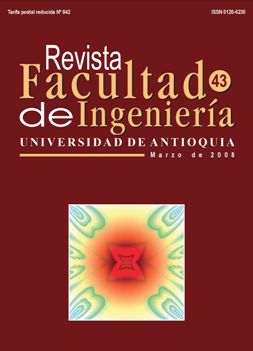Determination of the specific oxygen uptake rate in microorganisms including electrode time response
DOI:
https://doi.org/10.17533/udea.redin.18626Keywords:
specific oxygen transfer rate, oxygen electrode, time response, Ganoderma lucidumAbstract
The oxygen transfer rate is an important parameter for the aerobic fermentative process. By establishing the real oxygen uptake rate of the target organism we can determine the energetic and process requirements for aeration and agitation. We report in this paper the mathematical and methodological procedure for the determination of the specific oxygen uptake rate (QO2 ), taking the oxygen electrode response into account. This methodology was applied to the QO2 determination for the Ganoderma lucidum medicinal mushroom while it was being cultured in a stirred reactor in the laboratory. The average value for QO2 was 0.345 mmol O2 (g biomass.h)-1± 0.0171 without taking the electrode time response into account and 0.383 mmol O2 (g biomass.h)-1± 0.025 taking the electrode time response into account. Higher response times of the oxygen electrode resulted in a greater differences between the two QO2 values obtained.
Downloads
References
R. Scriban. Biotecnología. México. 2.a ed. El Manual moderno. 1985. pp. 170-183.
R. Quintero. Ingeniería bioquímica: Teoría y aplicaciones. 1.a ed. México. Ed. Alhambra Mexicana, S.A. Vol. 1981. pp. 288-291.
P. M. Doran. Principios de Ingeniería de los Bioprocesos. 1.a ed. Zaragoza (España). Ed. Acribia. 1995. pp. 207.
L. F. Muñoz, J. C. Quintero. Determinación del coeficiente de transferencia de oxígeno en la fermentación con Bacillus thuringiensis. Tesis de pregrado. Ingeniería Química. Universidad Nacional de Colombia, Bogotá. 1993. pp. 103.
M. L. Araujo, R. P. Oliveira, R. C. Giordano and C. O. Hokka. “Comparative studies on Cephalosporin C production process with free and immobilized cells of Cephalosporium acremonium ATCC 48272”. Chem. Eng. Science, 14th ISCRE. Vol. 51. 1996. pp. 2835-2840. DOI: https://doi.org/10.1016/0009-2509(96)00161-3
E. Gómez, V. E. Santos, A. Alcon, A. B. Martín, F. G. Ochoa. “Oxygen-Uptake and Mass-Transfer Rates on the Growth of Pseudomonas putida CECT5279: Influence on Biodesulfurization (BDS) capability Pseudomonas putida”. Energy & Fuels. Vol. 20. 2006. pp. 1565-1571. DOI: https://doi.org/10.1021/ef050362y
K. D. Rane, K. A. Sims. “Oxygen uptake and citric acid production by Candida lipolytica Y 1095”. Biotechnology and Bioengineering. Vol. 43. 1994. pp. 131-137. DOI: https://doi.org/10.1002/bit.260430205
A. C. Badino Jr., M. C. R Facciotti, W. Schmidell. “Improving KLa determination in fungal fermentation, taking into account electrode response time”. Journal Chemical Technology and Biotechnology. Vol. 75. 2000. pp. 469-474. DOI: https://doi.org/10.1002/1097-4660(200006)75:6<469::AID-JCTB236>3.0.CO;2-4
X.Yang, Z. Mao, S. Yang. “An improved method for determination of the volumetric oxygen transfer coefficient in fermentation process”. Biotechnology and Bioengineering. Vol. 31. 1988. pp. 1006-1009. DOI: https://doi.org/10.1002/bit.260310913
Downloads
Published
How to Cite
Issue
Section
License
Revista Facultad de Ingeniería, Universidad de Antioquia is licensed under the Creative Commons Attribution BY-NC-SA 4.0 license. https://creativecommons.org/licenses/by-nc-sa/4.0/deed.en
You are free to:
Share — copy and redistribute the material in any medium or format
Adapt — remix, transform, and build upon the material
Under the following terms:
Attribution — You must give appropriate credit, provide a link to the license, and indicate if changes were made. You may do so in any reasonable manner, but not in any way that suggests the licensor endorses you or your use.
NonCommercial — You may not use the material for commercial purposes.
ShareAlike — If you remix, transform, or build upon the material, you must distribute your contributions under the same license as the original.
The material published in the journal can be distributed, copied and exhibited by third parties if the respective credits are given to the journal. No commercial benefit can be obtained and derivative works must be under the same license terms as the original work.










 Twitter
Twitter